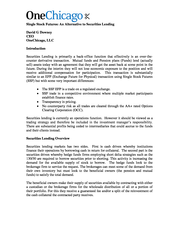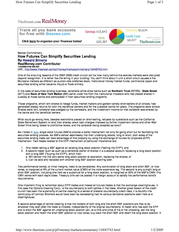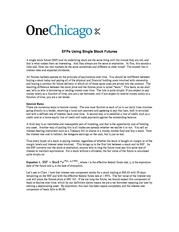Description
are used to disconnect the pricing of the transaction from its physical consummation. Instead of the buyer
paying a fixed price in cash, the buyer will grant the seller with a futures contract. Both parties are now
floating on the price and can fix their price by the selling repurchasing the future and the buyer selling the
future.
While differentials of grade and location do not obtain in the equities world, there are instances wherein a
stock buyer may wish to assure purchase of the shares while remaining floating on the price. For example,
an index fund positioning itself for a reconstitution and wishing to avoid the disruptions often seen around
index reconstitution time may buy the shares in advance and sell the futures.
The net position is zero; the long stock and short futures offset each other. Once the index fund is ready to buy the shares at a time allowed by its charter, all it has to do to fix the price is repurchase the SSFs. The SSF price becomes the purchase price of the shares. A second application of EFPs in the securities world is a dividend hedge.
If a stock is expected to raise its dividend after a near-month SSF expires, the intermonth or calendar trade of being long the near month and short a far month SSF would benefit from the increased dividend. EFPs In Basis Points A more generic application of the EFP is making or taking delivery prior to expiration. All futures contracts have a de facto European exercise. A long position can take delivery of the underlying asset at expiration, or the short position can make delivery of the underlying asset at, but not before, expiration. This restriction can be circumvented by trading the SSF for the underlying stock at or around its fair value. As an SSF and its underlying stock are equivalent at expiration, the resulting trade reflects the short-term interest rates and expected dividends involved and thus can be expressed in basis points, the convention used in all fixed income and many derivative markets: Equation 4. Basis = [ln(( Future + Div * e r*(t x −td ) ) / Stock ]− (t x −t0 ) / 360 The EFP process in SSFs gives us a clean and simple way to convert stock trades to interest rate trades, to learn about and manage dividend risk and to price the purchase and sale of a stock at a time of our convenience.
It also assures us the SSF and its underlying stock will remain priced in convergence with each other at fair value. If they deviate outside of their fair value bounds, they will be brought back in quickly by dedicated EFP traders and the market makers involved in the SSF pricing. Written by Howard Simons, the preceding is an abridged version of a column that appeard on RealMoney.com .
The net position is zero; the long stock and short futures offset each other. Once the index fund is ready to buy the shares at a time allowed by its charter, all it has to do to fix the price is repurchase the SSFs. The SSF price becomes the purchase price of the shares. A second application of EFPs in the securities world is a dividend hedge.
If a stock is expected to raise its dividend after a near-month SSF expires, the intermonth or calendar trade of being long the near month and short a far month SSF would benefit from the increased dividend. EFPs In Basis Points A more generic application of the EFP is making or taking delivery prior to expiration. All futures contracts have a de facto European exercise. A long position can take delivery of the underlying asset at expiration, or the short position can make delivery of the underlying asset at, but not before, expiration. This restriction can be circumvented by trading the SSF for the underlying stock at or around its fair value. As an SSF and its underlying stock are equivalent at expiration, the resulting trade reflects the short-term interest rates and expected dividends involved and thus can be expressed in basis points, the convention used in all fixed income and many derivative markets: Equation 4. Basis = [ln(( Future + Div * e r*(t x −td ) ) / Stock ]− (t x −t0 ) / 360 The EFP process in SSFs gives us a clean and simple way to convert stock trades to interest rate trades, to learn about and manage dividend risk and to price the purchase and sale of a stock at a time of our convenience.
It also assures us the SSF and its underlying stock will remain priced in convergence with each other at fair value. If they deviate outside of their fair value bounds, they will be brought back in quickly by dedicated EFP traders and the market makers involved in the SSF pricing. Written by Howard Simons, the preceding is an abridged version of a column that appeard on RealMoney.com .









